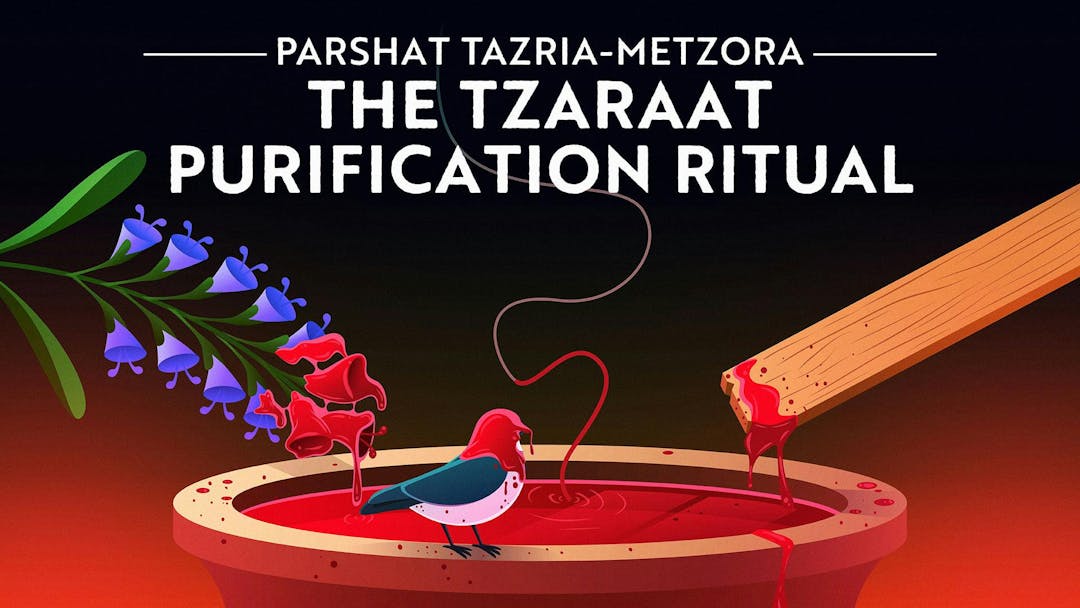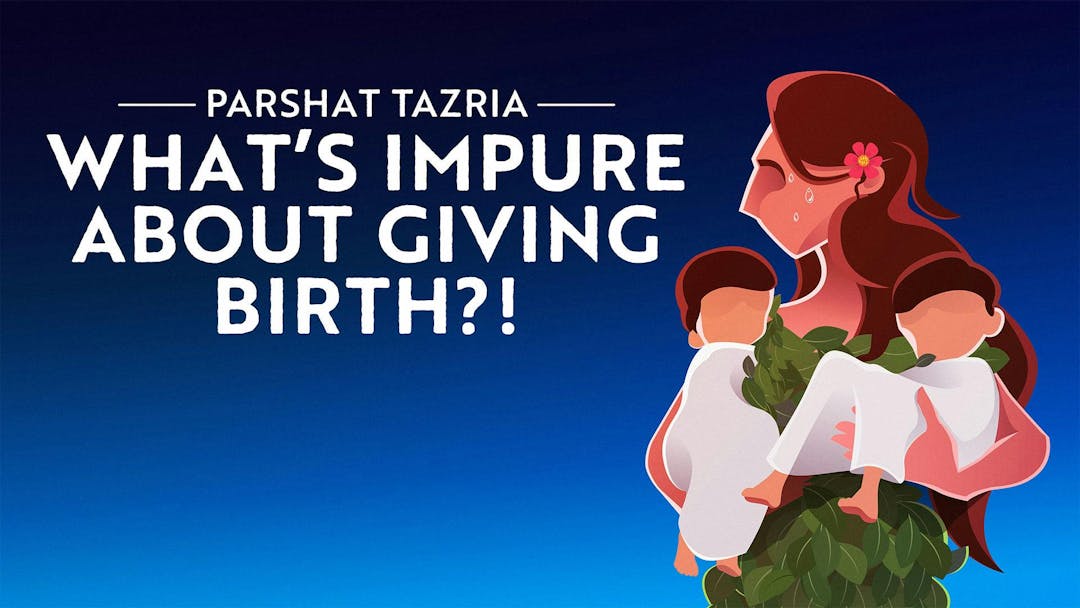The next time we read Tazria-Metzora is April 18, 2026
Parshat Tazria-Metzora
Tazria-Metzora Torah Portion: Leviticus 12:1–13:59
In this parsha, we learn about the post-childbirth purification process and we continue learning the laws of tzara'at.
Featured Tazria-Metzora Video
The Tzaraat Purification Ritual: What Does It Mean?
In Part I of this series, we connected the laws relating to the purification of a metzora to the laws of the korban Pesach. Why would that be? In Part II, Rabbi Fohrman puts the pieces together and reminds us that both teach us about 'radical separateness' – and while each of us is an individual, we are also part of a larger unit.
Tazria-Metzora Torah Portion
Tazria-Metzora Divrei Torah
Tazria-Metzora: Rejoining The Community
Printable Guide
A printable parsha guide for our Tazria-Metzora video, "Rejoining The Community."
Parshat Tazria-Metzora Summary
Tazria-Metzora Torah Portion: Leviticus 12:1–15:33
Parshat Tazria
Parshat Tazria, like a great deal of the Book of Leviticus, discusses the topic of tahara and tumah. These terms are difficult to translate (and possibly even more difficult to relate to in the 21st century). Do they correspond to cleanliness and uncleanliness? That translation doesn't seem right. Ritual purity and impurity? That may be closer — but what does it mean? Why do some things (childbirth, certain rashes of the skin, contact with certain animals, corpses) render a person "ritually impure"? And why should this matter to us today?
The classic implication of ritual impurity is that a person cannot do any rites associated with the Temple, cannot enter the Temple grounds to bring a sacrifice, etc. — but we have no Temple today, no sacrifices... so should it affect our lives at all? For an exploration of these questions and more, we recommend Imu and David's Parsha Experiment segment, "What Do Tumah and Tahara Mean Today?"
Now, Parshat Tazria opens with the specific case of a woman who has just given birth. She must wait out her period of ritual impurity (the length of time depends on whether the baby was a boy or a girl) and then immerse in a mikvah (ritual bath) and bring offerings to God. In the course of these laws, we are also reminded of the law to circumcise a boy when he is eight days old.
But following after those opening eight verses, we find that the whole rest of Parshat Tazria — and much Parshat Metzora — focuses on another case of tumah, spiritual impurity: the laws of a strange malady called tzara'at. Some translations render tzara’at as “leprosy” – but Rabbi Shimson Raphael Hirsch (in his comment on Leviticus 13:59) makes a very compelling case that biologically this isn’t leprosy. It does present with a physical manifestation, seemingly turning the skin a whitish color — but in other ways, it seems like a spiritual malady.
You may be wondering: what does childbirth have to do with the leprosy-like condition of tzara'at? Why does the Torah place them together in a single parsha? That is the question which Rabbi Forhman and Imu tackle in their thought-provoking Parsha Lab podcast on Tazria-Metzora.
Parshat Metzora
Parshat Metzora is commonly read in the same week as Parshat Tazria, and for good reason: together, these two parshiyot tell the full story of tzara'at, a mysterious ailment that renders people spiritually impure (tamei) and requires treatment. The verses in Parshat Tazria that describe the symptoms of tzara'at are extremely detailed and graphic and may even make our eyes glaze over, but by the time we get to Parshat Metzora and we read about the purification process for the metzora (the person afflicted with tzara'at), things start to get a little bit more interesting. What does the purification process look like? What needs to happen in order for the metzora to become pure (tahor) once again, to heal himself of his affliction?
It's a bizarre ritual: a priest (who is in charge of diagnosing the ailment and overseeing the ceremony) collects a series of seemingly-random objects: two birds, a plank made of cedar wood, a scarlet-colored thread, an earthenware vessel, a bundle of hyssop (a kind of herb), and living waters (generally understood to be water from a running stream). One of the birds is killed, and its blood is made to drip into a pool of the water into the vessel. Then the priest takes the live bird — along with the wood, the thread, and the hyssop — and he dips them into the blood of the dead bird and sprinkles them onto the metzora. The live bird is then sent away. At the end of this purification procedure, the metzora is allowed to come back into the camp, but he still has to wait outside of his home for seven days.
Is there any meaning, today, to be gleaned from the odd details of this ritual? The answer is yes, and here's where it begins: Rabbi Fohrman notices that the details of the purification process, strange though they may be, may also sound familiar to us. They harken back to another story in the Torah, an earlier story, one that also involved many of these elements: a bundle of hyssop, blood, wood, blood going into water, a seven-day period during which something had to stay outside of the house, this theme of two beings, one of which dies and one which is sent away. What is that story? It's a formative story in the history of the children of Israel, the story that details when the people became a nation. In the parallels between these two stories lies the exceedingly deep meaning of this strange purification process for the metzora — and indeed, a suggestion about the meaning of tzara'at itself. Rabbi Fohrman presents the full theory with all of his evidence in his two-part series on Tazria and Metzora, "The Tzaraat Purification Ritual: What Does It Mean?"
The fascinating topic of the metzora is not all that we find in this parsha. After concluding the topic, we read about other kinds of tumah, ritual impurity: like that of a man or woman who experiences a discharge, be it natural or unnatural, seminal or not. Contained in this discussion are the laws of the niddah, the menstruating woman, who is prohibited from marital relations and must observe a period of "clean days" after her period stops before she can immerse in a mikvah ("ritual bath"), which is needed for her to become tahor ("ritually pure"). If the rituals seem arbitrary, we ask the same question here: Why Does The Mikvah Make Me Pure?





